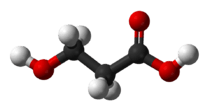3-Hydroxypropionic acid
| 3-Hydroxypropionic acid[1] | |
|---|---|
 | |
 | |
| 3-Hydroxypropanoic acid | |
| Other names 3-hydroxypropionic acid | |
| Identifiers | |
| CAS number | 503-66-2 |
| ChemSpider | 61460 |
| DrugBank | DB03688 |
| KEGG | C01013 |
| ChEBI | CHEBI:33404 |
| Jmol-3D images | Image 1 |
| |
| |
| Properties | |
| Molecular formula | C3H6O3 |
| Molar mass | 90.08 g/mol |
| Melting point | <25 °C 143 °C (sodium salt) |
| Boiling point | Decomposes |
| Solubility in water | Very soluble |
| Related compounds | |
| Related carboxylic acids | acetic acid glycolic acid propionic acid lactic acid malonic acid butyric acid hydroxybutyric acid |
| Related compounds | 1-propanol 2-propanol propionaldehyde acrolein |
| Except where noted otherwise, data are given for materials in their standard state (at 25 °C (77 °F), 100 kPa) | |
| Infobox references | |
3-Hydroxypropionic acid is a carboxylic acid, specifically a beta hydroxy acid. It is an acidic viscous liquid with a pKa of 4.5.[1] It is very soluble in water, soluble in ethanol, and miscible with diethyl ether. Upon distillation, it dehydrates to form acrylic acid.
3-Hydroxypropionic acid is used in the industrial production of various chemicals such as acrylates. It can be produced by engineered microbes.[2]
Applications in producing a biodegradable polymer
A method has been developed by the University of Minnesota to produce a biodegradable polymer polyester known as poly(3-hydroxypropionic acid).[3] The method combines the high-molecular weight and control aspects of ring-opening polymerization with the commercial availability of the beta hydroxy acid, 3-hydroxypropionic acid which is abbreviated as 3-HP. Since 3-HP can be derived from biological sources, the resulting material, poly(3-hydroxypropionic acid) or P(3-HP), is biorenewable. The new method allows direct synthesis of the bio-based polymer P(3-HP) from 3-HP, a commercial monomer that is derived from corn. The method uses a single vessel reactor for simple synthesis and rapid scale up. The method results in a higher molecular weight which makes the polymer more structurally sound using a process with lower toxicity than competing technologies.
See also
- Lactic acid (2-hydroxypropanoic acid)
- listed as hydracrylic acid in the Merck index, 12th Edition